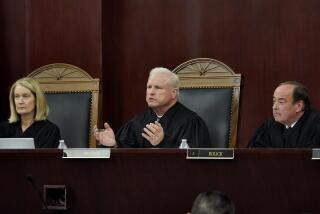Two roads to the Supreme Court
- Share via
WASHINGTON — As President Obama’s search for a Supreme Court justice progresses, it appears the White House has locked in on two competing sets of nominees: those who have traditional judicial and academic backgrounds and another group that comes from what might be called the “real world.”
Since Justice David H. Souter announced his retirement this month, much of the speculation about who will succeed him has centered on candidates such as U.S. Solicitor Gen. Elena Kagan, Judge Sonia Sotomayor of the U.S. 2nd Circuit Court of Appeals in New York and Judge Diane Wood of the U.S. 7th Circuit Court of Appeals in Chicago.
But the president’s own words have made some of the obvious favorites less obvious.
Obama said his choice would possess a “quality of empathy, of understanding and identifying with people’s hopes and struggles, as an essential ingredient for arriving at just decisions and outcomes.”
What Obama meant by a “quality of empathy” has been left to interpretation. The White House said the president was seeking a candidate with a diverse set of life experiences.
Sen. Patrick J. Leahy (D-Vt.), who chairs the committee that will conduct the nominee’s confirmation hearing, has echoed that idea, advising Obama to select someone from beyond the “judicial monastery.”
That seemingly would point away from prospects such as Kagan, a former dean of Harvard Law School, and Wood, who worked in the federal government before being named to the federal appeals court. And it could favor a candidate such as Sotomayor, a Latina and former New York prosecutor who grew up in a Bronx housing project.
Or such criteria could pave the way for a less traditional choice, such as Michigan Gov. Jennifer M. Granholm or Homeland Security Secretary Janet Napolitano. Granholm or Napolitano would provide a different profile for a Supreme Court nominee.
Granholm, 50, a Democrat, is a former federal prosecutor and state attorney general. Napolitano, 51, served in those capacities as well before twice being elected Arizona’s Democratic governor.
The White House also has hinted there are candidates who have not been publicly discussed.
Lee Epstein, a law professor at Northwestern University, said the Democrats’ comfortable majority in the Senate gave Obama maneuvering room to select a nontraditional nominee, though not necessarily a controversial one.
“He can do something bold if he wants, like Jennifer Granholm,” Epstein said. “In terms of ideology, it’s not going to be way, way left. It’ll be someone sort of in the mainstream.”
During the presidential campaign last year, Obama spoke admiringly of former Chief Justice Earl Warren, who was governor of California when he was appointed to the court in 1953.
“I think the president will do what he said and pick someone with experience in the real world, someone like Earl Warren. It could be a sitting governor or a senator,” said Michael J. Gerhardt, a law professor at the University of North Carolina. “That’s what Clinton tried to do but didn’t.”
In his first years in office, President Clinton approached New York Gov. Mario Cuomo and Maine Sen. George J. Mitchell about a high court vacancy, but neither was available. He also considered his Interior secretary, Bruce Babbitt, a former Arizona governor; and Education Secretary Richard W. Riley, a former governor of South Carolina. In the end, Clinton named two veteran judges -- Ruth Bader Ginsburg and Stephen G. Breyer.
The last justice to have served in elective office was Sandra Day O’Connor, a former Arizona state legislator who retired from the Supreme Court in 2006. On the court, she often showed political instincts, emerging as a centrist who helped build coalitions.
If Obama is searching for his own O’Connor, Granholm is an appealing choice. A Harvard Law School graduate, she is a two-term governor from a state that has been hammered by the declining economy. She has an advocate in Vice President Joe Biden, who had Granholm serve as a proxy for Alaska Gov. Sarah Palin as Biden prepared for the vice presidential debates last year.
“She’s a tour de force,” said David M. Uhlmann, a law professor at the University of Michigan. “She has an admirable intellect, clearly a very sophisticated legal mind, and the personal quality and the empathy the president has spoken about having in a Supreme Court candidate.”
Others who have been mentioned as potential nominees include Massachusetts Gov. Deval Patrick, a Harvard Law School graduate and former Justice official; Interior Secretary Ken Salazar, a former senator and state attorney general in Colorado; and Minnesota Sen. Amy Klobuchar, a former prosecutor and a graduate of the University of Chicago Law School. All are Democrats.
On Monday, Sens. Barbara Boxer (D-Calif.) and Olympia J. Snowe (R-Maine) sent the White House a letter saying Obama’s choice should be a woman. “In order for the court to be relevant, it needs to be diverse and better reflect America,” the senators wrote.
--
david.savage@latimes.com
More to Read
Get the L.A. Times Politics newsletter
Deeply reported insights into legislation, politics and policy from Sacramento, Washington and beyond. In your inbox twice per week.
You may occasionally receive promotional content from the Los Angeles Times.











